英语语言学概论笔记
英语语言学笔记1-何兆熊
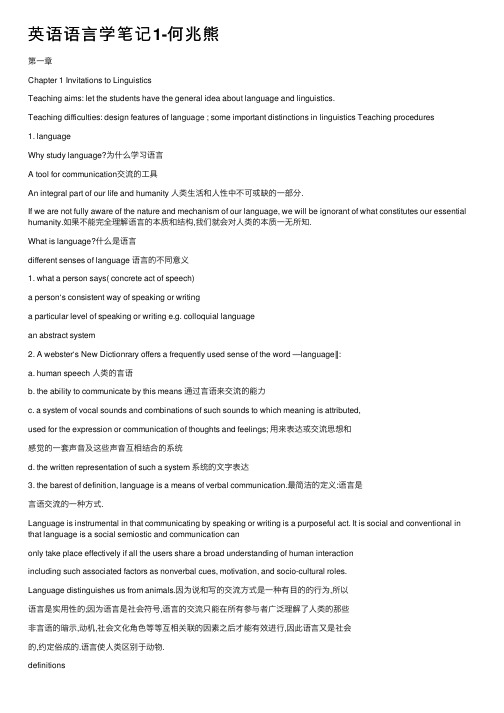
英语语⾔学笔记1-何兆熊第⼀章Chapter 1 Invitations to LinguisticsTeaching aims: let the students have the general idea about language and linguistics.Teaching difficulties: design features of language ; some important distinctions in linguistics Teaching procedures1. languageWhy study language?为什么学习语⾔A tool for communication交流的⼯具An integral part of our life and humanity ⼈类⽣活和⼈性中不可或缺的⼀部分.If we are not fully aware of the nature and mechanism of our language, we will be ignorant of what constitutes our essential humanity.如果不能完全理解语⾔的本质和结构,我们就会对⼈类的本质⼀⽆所知.What is language?什么是语⾔different senses of language 语⾔的不同意义1. what a person says( concrete act of speech)a person‘s consistent way of speaking or writinga particular level of speaking or writing e.g. colloquial languagean abstract system2. A webster‘s New Dictionrary offers a frequently used sense of the word ―language‖:a. human speech ⼈类的⾔语b. the ability to communicate by this means 通过⾔语来交流的能⼒c. a system of vocal sounds and combinations of such sounds to which meaning is attributed,used for the expression or communication of thoughts and feelings; ⽤来表达或交流思想和感觉的⼀套声⾳及这些声⾳互相结合的系统d. the written representation of such a system 系统的⽂字表达3. the barest of definition, language is a means of verbal communication.最简洁的定义:语⾔是⾔语交流的⼀种⽅式.Language is instrumental in that communicating by speaking or writing is a purposeful act. It is social and conventional in that language is a social semiostic and communication canonly take place effectively if all the users share a broad understanding of human interactionincluding such associated factors as nonverbal cues, motivation, and socio-cultural roles.Language distinguishes us from animals.因为说和写的交流⽅式是⼀种有⽬的的⾏为,所以语⾔是实⽤性的;因为语⾔是社会符号,语⾔的交流只能在所有参与者⼴泛理解了⼈类的那些⾮⾔语的暗⽰,动机,社会⽂化⾓⾊等等互相关联的因素之后才能有效进⾏,因此语⾔⼜是社会的,约定俗成的.语⾔使⼈类区别于动物.definitionsLanguage is a system of arbitrary vocal symbols used for human communication.What is communication?A process in which information is transmitted from a source (sender or speaker) to a goal (receiveror listener).A system----since elements in it are arranged according to certain rules systematically, rather thanrandomly. They cannot be arranged at will. e.g. He the table cleaned. (×) bkli (×) Why do we say language is arbitrary? Arbitrary----there is no intrinsic (logic) connection between a linguistic form and its meaning, between the sounds that people use and the objects to which these sounds refer. Thisexplains and is explained by the fact that different language have different words for thesame object, it is good illustration of the arbitrary nature of language . it is only our tacitagreement of utterance and concept at work and not any innate relationship bound upin the utterance. A typical example to illustrate the arbitrary of language is a famousquotation from shakepeare‘s play:‖ Romeo and Juliet: A rose by any other name wouldsmell as sweet.⼀朵玫瑰不管它叫什么名字,闻起来都是⼀样⾹的.Symbols----words are just the symbols associated with objects, actions, and ideas by nothing but convention. Namely, people use the sounds or voval forms to symbolize what they wishto refer to.Vocal-------- the primary medium for all languages is sound, no matter how well developed their writing systems are. Writing systems came much later than the spoken forms. The factthat small children learn and can only learn to speak and listen before they write or readalso indicates that language is primarily vocal, rather than written.Writing systems came into being much later than the spoken forms.People with little or no literacy can also be competent language users.Human ----language is human-specific.Human beings have different kinds of brains and vocal capacity.―Language Acquisition Device‖(LAD)⼆.What characteristics of langauge do you think should be included in a good ,comprenhensive definition of language? Language is a rule-governed system; langauge is basically vocal; langauge is arbitrary ; langague is used for human communication.1.3 Design features of language 语⾔的结构特征Design features------ refers to the defining properties of human language that distinguish it from any animal system of communication. They are arbitrariness, duality, creativity/ productivity, displacement, clutural transmission and interchangeability.Design features----- are features that define our human languages,such asarbitrariness,duality,creativity,displacement,cultural transmission,etc.(指决定了⼈类语⾔性质的特征.例如任意性,⼆重性,创造性,移位性,⽂化转移性等.)The American linguist Charles Hockett specified twelve design features.What is arbitrariness?任意性a. arbitrariness【'ɑ?b?tr?r?n?s】----arbitrariness(任意性): one design feature of humanlanguage,which refers to the fact that the forms of linguistic signs bear no naturalrelationship to their meaning.(⼈类语⾔的本质特征之⼀,指语⾔符号的形式与意义之间没有⾃然的联系.)It was discussed by Saussure first.The link between them is a matter of convention.E.g. ―house‖ uchi (Japanese)Mansion (French)房⼦(Chinese)(1) arbitrary between the sound of a morpheme and its meaning语⾔的⾳和义之间的任意性a. By ―arbitrary‖, we mean there is no logical connection between meanings and sounds. 语⾔的意义和语⾳之间没有逻辑关系。
语言学概论 自学笔记 第五章 语义

第五章语义一、名词解释1.语义2.理性意义3.非理性意义4.词汇意义5.语法意义6.语境意义7.词义 8.词的理性意义 9.词的非理性意义 10.感情色彩 11.语体色彩 12.形象色彩13.词义的模糊性 14.词的通俗意义和科学意义 15.义项 16.义素 17.义素分析18.单义词 19.多义词 20.本义 21.基本义 22.派生义 23.同义词 24.等义词25.近义词 26.反义词 27.绝对反义词和相对反义词 28.语义场 29.上位词、下位词30.词汇意义 31.关系意义 32.语法关系意义 33.语义关系意义 34.语气意义35.述谓结构及四种类型 36.变元 38.语义指向 39.蕴含 40.预设41.歧义二、简答及论述1.在语义中,句义和词义具有突出的地位.2.词义的概括性.3.举例说明依靠语境的限定作用,表达概括意义的语言形式可以有具体的、个别的所指.4.简要说明语义的民族性。
(含义、表现)5.为什么说同语言形式的结合是语义的基本特征?6.语境意义和语言意义有什么不同,为什么要区分二者?7.语义模糊性的含义和特点.8.为什么说语义的模糊性是社会交际活动的需要.(作用)9.词的理性意义的产生.10.词义也可以反映精神世界的对象.11.词的理性意义在词义中的地位.12.关于义项:13、为什么义素是理论分析的结果,是一种不与语音形式相联系的抽象的语义单位?14.义素分析的基本方法和步骤.15.义素分析法的简明步骤16.义素分析的运用17.义素分析的目的和要求.18.义素分析的作用.19.义素分析存在的问题.20.词的语体色彩和词语使用的关系如何?21.形象色彩和词语构造有什么关系.22.为什么相同的语音形式和书写形式所表达的几个意思并不一定就是同一个词的几个义项?23.为什么说明或掌握一个词的意义和用法时,应该以义项为基本单位.24.语义学领域的义素分析法和语法学领域的语义特征分析法有什么联系和区别.25.本义和基本义可能一致,也可能不一致.26.派生义产生的途径是什么?27.一个词虽然有几个意义,但在使用中一般不会产生歧义,简述其原因。
英语语言学笔记
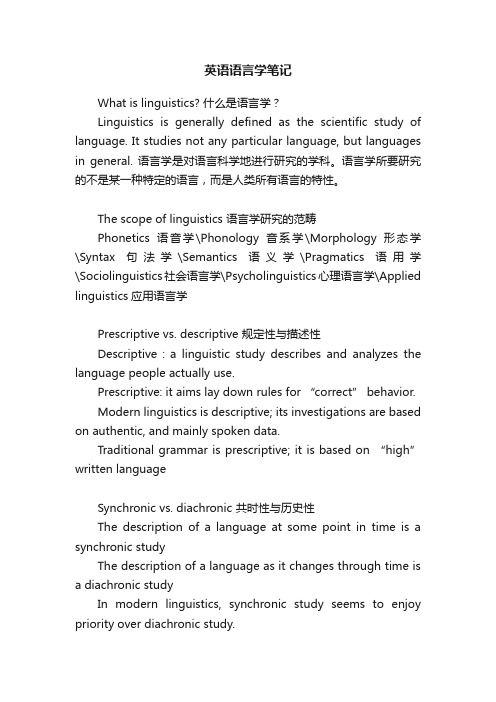
英语语言学笔记What is linguistics? 什么是语言学?Linguistics is generally defined as the scientific study of language. It studies not any particular language, but languages in general. 语言学是对语言科学地进行研究的学科。
语言学所要研究的不是某一种特定的语言,而是人类所有语言的特性。
The scope of linguistics 语言学研究的范畴Phonetics语音学\Phonology音系学\Morphology形态学\Syntax句法学\Semantics语义学\Pragmatics语用学\Sociolinguistics社会语言学\Psycholinguistics心理语言学\Applied linguistics应用语言学Prescriptive vs. descriptive 规定性与描述性Descriptive:a linguistic study describes and analyzes the language people actually use.Prescriptive: it aims lay down rules for “correct” behavior.Modern linguistics is descriptive; its investigations are based on authentic, and mainly spoken data.Traditional grammar is prescriptive; it is based on “high” written languageSynchronic vs. diachronic 共时性与历史性The description of a language at some point in time is a synchronic studyThe description of a language as it changes through time is a diachronic studyIn modern linguistics, synchronic study seems to enjoy priority over diachronic study.Speech and writing 口头语与书面语Speech enjoys priority over writing in modern linguistics study for the following reasons:(1) speech precedes writing in terms of evolution(2) a large amount of communication is carried out in speech tan in writing(3) speech is the form in which infants acquire their native languageLanguage and parole 语言与言语Language refers to the abstract linguistic system shared by all the members of a speech communityParole refers to the realization of language in actual useCompetence and performance 能力与运用Chomsky defines competence as the ideal users’ knowledge of the rules of his languagePerformance: the actual realization of this knowledge in linguistic communicationWhat is language? 什么是语言?Language is a system of arbitrary vocal symbols used for human communicationCharacteristics of language: 语言的特性Language is a rule-governed systemLanguage is basically vocalLanguage is arbitrary (the fact different languages have different words for the same object is a good illustration of the arbitrary nature of language. This conventional nature oflanguage is well illustrated by a famous quotation from Shakespeare’s play “Romeo and Juliet”: “A rose by any other name would smell as sweet.”)Language is used for human communicationDesign features of language 语言的甄别特征American linguist Charles Hockett specified 12 design features:1) arbitrariness 武断性2) productivity 创造性3) duality 二重性4) displacement移位性5) cultural transmission 文化传递性二、音系学语言的声音媒介什么是语音学发音器官音标……宽式和严式标音法英语语音的分类音系学和语音学语音、音位、音位变体音位对立、互补分部、最小对立几条音系规则超切分特征Two major media of communication: speech and writingThe limited range of sounds which are meaningful in human communication and are of interest to linguistic studies are the phonic medium of language. 用于人类语言交际的声音称为语音,这些数目有限的一组语音构成了语言的声音媒介。
英语语言学笔记第四章

句法(syntax)这个单词,来自希腊语,由两个语素构成:﹛syn﹜和﹛tax﹜。
﹛syn﹜的意思是"一起、共同",﹛tax﹜的意思是"安排、排列",因此syntax本来是"排列在一起"或"组合"的意思。
在语言学上,它是指研究语言中词组合成句子的支配规则,或者简单地说,是研究句子的构造。
因为通常认为句子是语言中最大的语法单位,所以句法长期以来是语法研究的核心。
不同的语言学理论首先体现在对句子结构的不同处理上。
这一章我们将介绍一些有代表性的句法学派。
4.1 传统学派传统认为句子是词的序列。
因此句子构造的研究涉及了对词的大量研究,例如,词类是对词进行的分类,主语、谓语是对词功能的描写,等等。
这些词类和功能有时叫做范畴。
但是"范畴"这个术语,更专门用于表示像名词、动词这些单位的特性。
例如:常说名词有数、性、格的范畴,动词有时、体、态的范畴。
在这里,我们将简要地讨论以上一些范畴。
名词、动词、形容词等形式在有关范畴中的相互关系将在"一致关系和支配关系"中讨论。
4.1.1 数、性、格4.1.2 时和体4.1.3 一致关系和支配关系4.1.1 数、性、格数(number),主要是名词和代词的范畴,如:a book(一本书);some books(一些书);I(我),we(我们);he(他),they(他们)。
英语动词也反映了数的范畴,如:He speaks English.(他说英语);They speak English.(他们说英语)。
在法语等语言中,形容词和冠词也有数的变化,如:le cheval royal,les chevaux royaux。
数一般有两种:单数和复数。
但是在古希腊语、阿拉伯语等语言中,还有第三种数:双数,类似于英语中的both(双方,两者)。
斐济群岛语还有第四种数:三数。
英语语言学概论知识点总结

英语语言学概论知识点总结English linguistics is a fascinating field that delves into the structure, variation, and evolution of the English language. It encompasses phonetics, which studies the sounds of speech, and phonology, the system of sounds in a language.Morphology, the study of word formation, and syntax, which examines sentence structure, are crucial components of linguistics. They reveal how words are constructed and how they combine to form meaningful sentences.Semantics, the study of meaning in language, and pragmatics, which looks at language in use and the context in which it is spoken, help us understand how language conveys information and intention.Sociolinguistics explores the relationship between language and society, including how dialects and accents vary across different social groups and regions.Psycholinguistics, on the other hand, investigates the cognitive processes involved in language acquisition and use, shedding light on how we learn and understand language.Historical linguistics traces the development of the English language over time, from its roots in Old English through to the modern language we speak today.Finally, applied linguistics takes the theoretical knowledge from these areas and applies it to real-world problems, such as language teaching, translation, and language policy development.In summary, English linguistics offers a comprehensive view of the language, from its smallest units to its role in society, and from its past to its present and future forms.。
语言学概论读书笔记
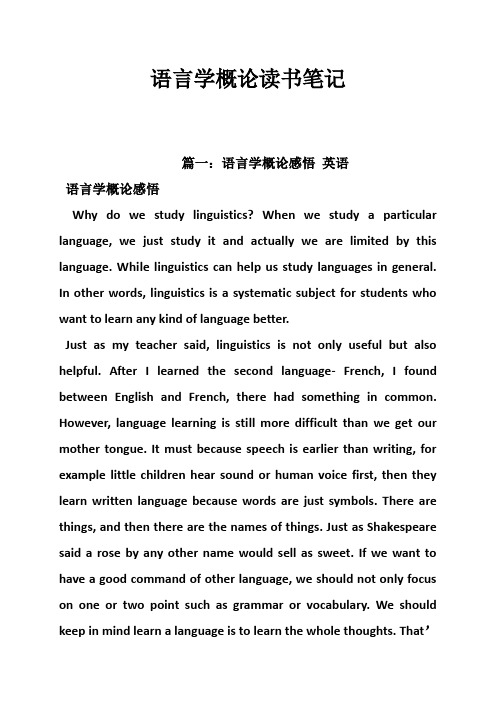
语言学概论读书笔记篇一:语言学概论感悟英语语言学概论感悟Why do we study linguistics? When we study a particular language, we just study it and actually we are limited by this language. While linguistics can help us study languages in general. In other words, linguistics is a systematic subject for students who want to learn any kind of language better.Just as my teacher said, linguistics is not only useful but also helpful. After I learned the second language- French, I found between English and French, there had something in common. However, language learning is still more difficult than we get our mother tongue. It must because speech is earlier than writing, for example little children hear sound or human voice first, then they learn written language because words are just symbols. There are things, and then there are the names of things. Just as Shakespeare said a rose by any other name would sell as sweet. If we want to have a good command of other language, we should not only focus on one or two point such as grammar or vocabulary. We should keep in mind learn a language is to learn the whole thoughts. That’s why we should study linguistics.Students always have rare interests in language learning for they don’t find a effective way to study it. When we recite words and try to understand the complicated grammar, we may be bored and tired, that’s because we do not know language’s similarities and generalizations. If we study linguistics, we can have a systematic recognition. During a period of time of learning, I find that linguistics has a widely use in language learning. Just like we read a sentence, we should consider the logical meaning of it because we shall know a word by the company it keeps, or we will make mistakes. If we learn linguistic, we can benefit a lot in language learning and find the beauty of the language.篇二:现代汉语读书笔记现代汉语读书笔记第一章引论第一节汉语和现代汉语一、现代汉语的性质(一)什么是现代汉语1.语言的属性语言是人类社会特有的产物,劳动创造了语言。
英语语言学概论第八章笔记

Chapter 8 Socio-linguistics 社会语言学1.What is socio-linguistics? 什么是社会语言学?Sociolinguistics is the sub-discipline of linguistics that studies language in social contexts.社会语言学是语言学的一个分支,它研究社会环境中的语言。
nguage variation 语言变异a)Speech community 言语社区In sociolinguistic studies, speakers are treated as members of social groups. The social group isolated for any given study is called speech community. A speech community thus defined as a group of people who form a community (which may have as few members as a family or as many member as a country), and share the same language or a particular variety of language. The important characteristic of a speech community is that the members of the group must, in some reasonable way, interact linguistically with other members of the community. They may share closely related language varieties, as well as attitudes toward linguistic norms.社会语言学研究中,说话者被当作是社会群体的成员。
英语语言学笔记第四章
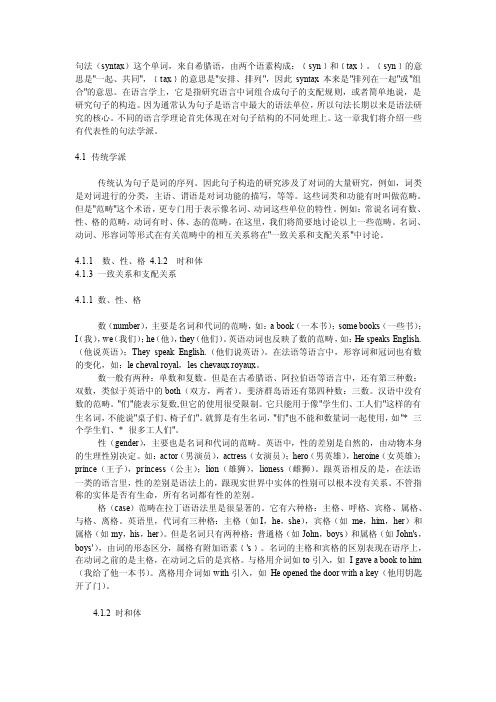
句法(syntax)这个单词,来自希腊语,由两个语素构成:﹛syn﹜和﹛tax﹜。
﹛syn﹜的意思是"一起、共同",﹛tax﹜的意思是"安排、排列",因此syntax本来是"排列在一起"或"组合"的意思。
在语言学上,它是指研究语言中词组合成句子的支配规则,或者简单地说,是研究句子的构造。
因为通常认为句子是语言中最大的语法单位,所以句法长期以来是语法研究的核心。
不同的语言学理论首先体现在对句子结构的不同处理上。
这一章我们将介绍一些有代表性的句法学派。
4.1 传统学派传统认为句子是词的序列。
因此句子构造的研究涉及了对词的大量研究,例如,词类是对词进行的分类,主语、谓语是对词功能的描写,等等。
这些词类和功能有时叫做范畴。
但是"范畴"这个术语,更专门用于表示像名词、动词这些单位的特性。
例如:常说名词有数、性、格的范畴,动词有时、体、态的范畴。
在这里,我们将简要地讨论以上一些范畴。
名词、动词、形容词等形式在有关范畴中的相互关系将在"一致关系和支配关系"中讨论。
4.1.1 数、性、格4.1.2 时和体4.1.3 一致关系和支配关系4.1.1 数、性、格数(number),主要是名词和代词的范畴,如:a book(一本书);some books(一些书);I(我),we(我们);he(他),they(他们)。
英语动词也反映了数的范畴,如:He speaks English.(他说英语);They speak English.(他们说英语)。
在法语等语言中,形容词和冠词也有数的变化,如:le cheval royal,les chevaux royaux。
数一般有两种:单数和复数。
但是在古希腊语、阿拉伯语等语言中,还有第三种数:双数,类似于英语中的both(双方,两者)。
斐济群岛语还有第四种数:三数。
英语语言学概论第七章笔记.
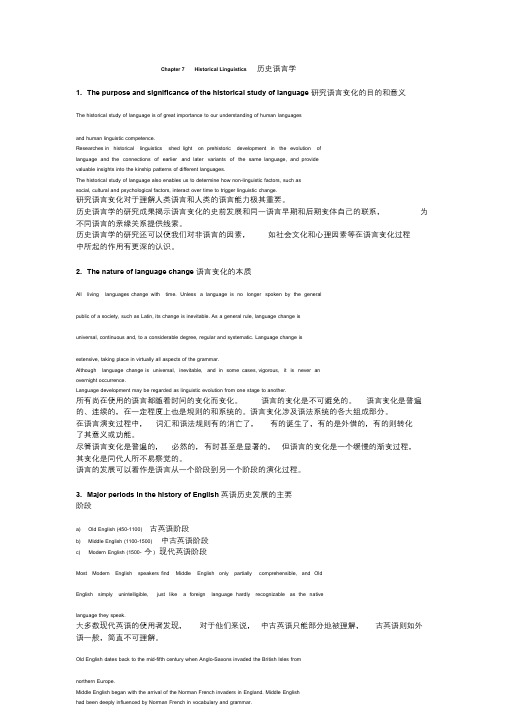
Chapter 7 Historical Linguistics 历史语言学1. The purpose and significance of the historical study of language 研究语言变化的目的和意义The historical study of language is of great importance to our understanding of human languagesand human linguistic competence.Researches in historical linguistics shed light on prehistoric development in the evolution oflanguage and the connections of earlier and later variants of the same language, and providevaluable insights into the kinship patterns of different languages.The historical study of language also enables us to determine how non-linguistic factors, such associal, cultural and psychological factors, interact over time to trigger linguistic change.研究语言变化对于理解人类语言和人类的语言能力极其重要。
历史语言学的研究成果揭示语言变化的史前发展和同一语言早期和后期变体自己的联系,为不同语言的亲缘关系提供线索。
历史语言学的研究还可以使我们对非语言的因素,如社会文化和心理因素等在语言变化过程中所起的作用有更深的认识。
语言学概论笔记(第五章)(4)
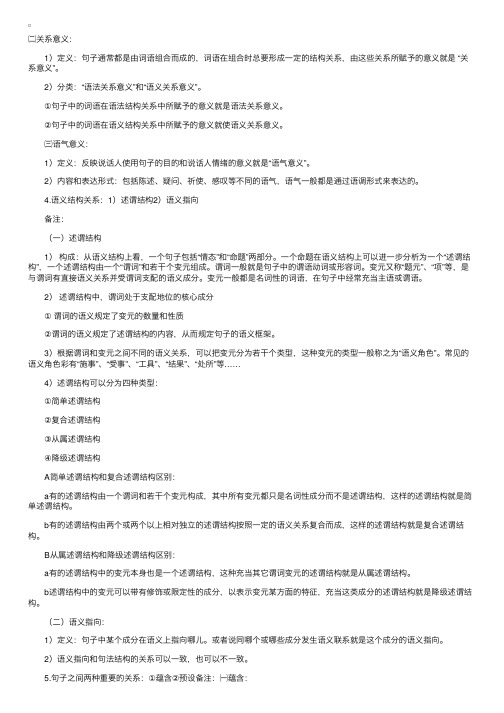
㈡关系意义: 1)定义:句⼦通常都是由词语组合⽽成的,词语在组合时总要形成⼀定的结构关系,由这些关系所赋予的意义就是 “关系意义”。
2)分类:“语法关系意义”和“语义关系意义”。
①句⼦中的词语在语法结构关系中所赋予的意义就是语法关系意义。
②句⼦中的词语在语义结构关系中所赋予的意义就使语义关系意义。
㈢语⽓意义: 1)定义:反映说话⼈使⽤句⼦的⽬的和说话⼈情绪的意义就是“语⽓意义”。
2)内容和表达形式:包括陈述、疑问、祈使、感叹等不同的语⽓,语⽓⼀般都是通过语调形式来表达的。
4.语义结构关系:1)述谓结构2)语义指向 备注: (⼀)述谓结构 1)构成:从语义结构上看,⼀个句⼦包括“情态”和“命题”两部分。
⼀个命题在语义结构上可以进⼀步分析为⼀个“述谓结构”,⼀个述谓结构由⼀个“谓词”和若⼲个变元组成。
谓词⼀般就是句⼦中的谓语动词或形容词。
变元⼜称“题元”、“项”等,是与谓词有直接语义关系并受谓词⽀配的语义成分。
变元⼀般都是名词性的词语,在句⼦中经常充当主语或谓语。
2)述谓结构中,谓词处于⽀配地位的核⼼成分 ①谓词的语义规定了变元的数量和性质 ②谓词的语义规定了述谓结构的内容,从⽽规定句⼦的语义框架。
3)根据谓词和变元之间不同的语义关系,可以把变元分为若⼲个类型,这种变元的类型⼀般称之为“语义⾓⾊”。
常见的语义⾓⾊彩有“施事”、“受事”、“⼯具”、“结果”、“处所”等…… 4)述谓结构可以分为四种类型: ①简单述谓结构 ②复合述谓结构 ③从属述谓结构 ④降级述谓结构 A简单述谓结构和复合述谓结构区别: a有的述谓结构由⼀个谓词和若⼲个变元构成,其中所有变元都只是名词性成分⽽不是述谓结构,这样的述谓结构就是简单述谓结构。
b有的述谓结构由两个或两个以上相对独⽴的述谓结构按照⼀定的语义关系复合⽽成,这样的述谓结构就是复合述谓结构。
B从属述谓结构和降级述谓结构区别: a有的述谓结构中的变元本⾝也是⼀个述谓结构,这种充当其它谓词变元的述谓结构就是从属述谓结构。
英语语言学笔记第三章
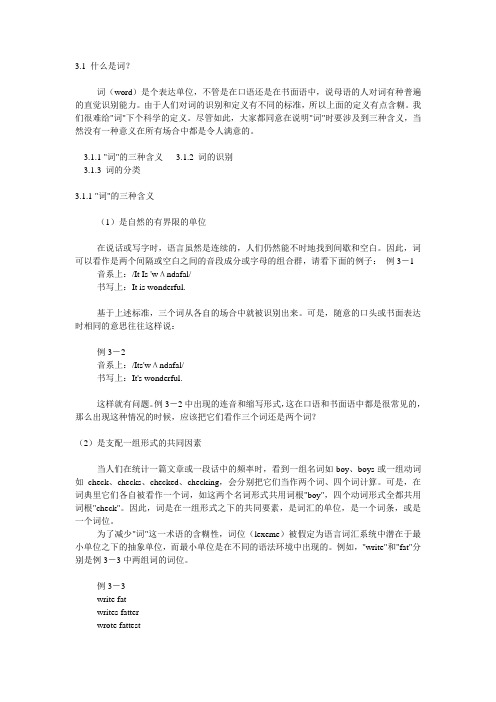
- A.
3.1.3词的分类
我们能归纳出词的一些共同特征,但同时也发现不同词之间存在着这样那样的差别。
(1)可变化词和不变词
根据可变性可以对词进行分类。关于可变化词(variable words),人们可以找到一系列整齐而有规则的词形,它们在语法上是不同的;另一方面,词的一部分相对保持不变。因此每一个整齐的系列构成一个聚合。
书写上:It is wonderful.
基于上述标准,三个词从各自的场合中就被识别出来。可是,随意的口头或书面表达时相同的意思往往这样说:
例3-2
音系上:/Its'wΛndafal/
书写上:It's wonderful.
这样就有问题。例3-2中出现的连音和缩写形式,这在口语和书面语中都是很常见的,那么出现这种情况的时候,应该把它们看作三个词还是两个词?
根据夸克(Qurk,et al 1985:253)等人的看法,限定词(determiner)有三个小类:前置限定词,中置限定词,后置限定词。前置限定词包括all、both、half、double、twice、three times、one-fifth等。最常见、最典型的中置限定词是有定冠词和无定冠词。其他还有this、that、these、those、every、each、some、any、no、either、neither、my、our、your、his、her、its、their等。后置限定词包括基数词,序数词,一般顺序词如next、last、past、(an)other、additional,其他数量词如many、(a) few、several、much、little、a lot of、plenty of、a great deal of、a great number of等。
英语语言学概论--整理
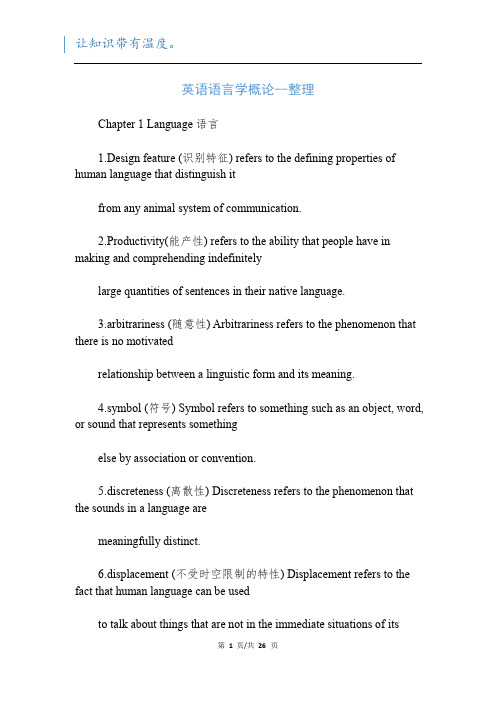
英语语言学概论--整理Chapter 1 Language语言1.Design feature (识别特征) refers to the defining properties of human language that distinguish itfrom any animal system of communication.2.Productivity(能产性) refers to the ability that people have in making and comprehending indefinitelylarge quantities of sentences in their native language.3.arbitrariness (随意性) Arbitrariness refers to the phenomenon that there is no motivatedrelationship between a linguistic form and its meaning.4.symbol (符号) Symbol refers to something such as an object, word, or sound that represents somethingelse by association or convention.5.discreteness (离散性) Discreteness refers to the phenomenon that the sounds in a language aremeaningfully distinct.6.displacement (不受时空限制的特性) Displacement refers to the fact that human language can be usedto talk about things that are not in the immediate situations of itsusers.7.duality of structure (结构二重性) The organization of language into two levels, one of sounds, theother of meaning, is known as duality of structure.8.culture transmission (文化传扬) Culture transmission refers to the fact that language is passedon from one generation to the next through teaching and learning, rather than by inheritance.9.interchangeability (互换性) Interchangeability means that any human being can be both a producerand a receiver of messages.1.★What is language?Language is a system of arbitrary vocal symbols used for human communication. This definition has captured the main features of language.First, language is a system.Second, language is arbitrary in the sense.The third feature of language is symbolic nature.2.★What are the design features of language?Language has seven design features as following:1) Productivity.2) Discreteness.3) Displacement4) Arbitrariness.5) Cultural transmission6) Duality of structure.7) Interchangeability.3.Why do we say language is a system?Because elements of language are combined according to rules, and every language contains a set of rules. By system, the recurring patterns or arrangements or the particular ways or designs in whicha language operates. And the sounds, the words and the sentences are used in fixed patterns that speakerof a language can understand each other.4.★ (Function of language.) According to Halliday, what are the initial functions of children’slanguage? And what are the three functional components of adult language?I.Halliday uses the following terms to refer to the initial functions of children’s language:1) Instrumental function. 工具功能2) Regulatory function. 调整功能3) Representational function. 表现功能4) Interactional function. 互动功能5) Personal function. 自指性功能6) Heuristic function. 启发功能[osbQtq`kf`h]7) Imaginative function. 想象功能II.Adult language has three functional components as following:1) Interpersonal components. 人际2) Ideational components.概念3) Textual components.语篇Chapter 2 Linguistics语言学1.general linguistics and descriptive linguistics (一般语言学与描写语言学) The former deals withlanguage in general whereas the latter is concerned with one particular language.2.synchronic linguistics and diachronic linguistics (共时语言学与历时语言学) Diachronic linguisticstraces the historical development of the language and records thechanges that have taken place in it between successive points in time. And synchronic linguistics presents an account of language as it is at some particular point in time.3.theoretical linguistics and applied linguistics (理论语言学与应用语言学) The former copes withlanguages with a view to establishing a theory of their structures and functions whereas the latter is concerned with the application of the concepts and findings of linguistics to all sorts of practical tasks.4.microlinguistics and macrolinguistics(微观语言学与宏观语言学) The former studies only the structureof language system whereas the latter deals with everything that is related to languages.ngue and parole (语言与言语) The former refers to the abstract linguistics system shared by allthe members of a speech community whereas the latter refers to the concrete act of speaking in actual situation by an individual speaker.6petence and performance (语言能力与语言运用) The former is one’s knowledge of all the linguisticregulation systems whereas the latter is the use of language in concrete situation.7.speech and writing(口头语与书面语) Speech is the spoken form of language whereas writing is writtencodes, gives language new scope.8.linguistics behavior potential and actual linguistic behavior (语言行为潜势与实际语言行为) Peopleactually says on a certain occasion to a certain person is actual linguistics behavior. And each of possible linguistic items that he could have said is linguistic behavior potential.9.syntagmatic relation and paradigmatic relation (横组合关系与纵聚合关系) The former describes thehorizontal dimension of a language while the latter describes the vertical dimension of a language.10.verbal communication and non-verbal communication (言语交际与非言语交际) Usual use of language asa means of transmitting information is called verbal communication. The ways we convey meaning withoutusing language is called non-verbal communication.1.★How does John Lyons classify linguistics?According to John Lyons, the field of linguistics as a whole can be divided into several subfields as following:1) General linguistics and descriptive linguistics.2) Synchronic linguistics and diachronic linguistics.3) Theoretical linguistics and applied linguistics.4) Microlinguistics and macrolinguistics.2.Explain the three principles by which the linguist is guided: consistency, adequacy and simplicity.1) Consistency means that there should be no contradictions between different parts of the theoryand the description.2) Adequacy means that the theory must be broad enough in scope to offer significant generalizations.3) Simplicity requires us to be as brief and economic as possible.3.★What are the sub-branches of linguistics within the language system?Within the language system there are six sub-branches as following:1) Phonetics. 语音学is a study of speech sounds of all human languages.2) Phonology. 音位学studies about the sounds and sound patterns of a speaker’s native language.3) Morphology. 形态学studies about how a word is formed.4) Syntax. 句法学studies about whether a sentence is grammatical or not.5) Semantics. 语义学studies about the meaning of language, including meaning of words and meaningof sentences.6) Pragmatics. 语用学★The scope of language: Linguistics is referred to as a scientific study of language.★The scientific process of linguistic study: It involves four stages: collecting data, forming a hypothesis, testing the hypothesis and drawing conclusions.Chapter 3 Phonetics语音学1.articulatory phonetics(发音语音学) The study of how speech organs produce the sounds is calledarticulatory phonetics.2.acoustic phonetics(声学语音学) The study of the physical properties and of the transmission of speechsounds is called acoustic phonetics.3.auditory phonetics(听觉语音学) The study of the way hearers perceive speech sounds is called auditoryphonetics.4.consonant (辅音) Consonant is a speech sound where the air form the language is either completelyblocked, or partially blocked, or where the opening between the speech organs is so narrow that the air escapes with audible friction.5.vowel (元音) is defined as a speech sound in which the air from the lungs is not blocked in any wayand is pronounced with vocal-cord vibration.6.bilabials (双唇音) Bilabials means that consonants for which the flow of air is stopped or restrictedby the two lips. [p][b] [m] [w]7.affricates (塞擦音) The sound produced by stopping the airstream and then immediately releasing itslowly is called affricates. [t X] [d Y] [tr] [dr]8.glottis (声门) Glottis is the space between the vocal cords.9.rounded vowel (圆唇元音) Rounded vowel is defined as the vowel sound pronounced by the lips forminga circular opening. [u:] [u] [OB] [O]10.diphthongs (双元音) Diphthongs are produced by moving from one vowel position to another throughintervening positions.[ei][ai][O i] [Q u][au]11.triphthongs (三合元音) Triphthongs are those which are produced by moving from one vowel positionto another and then rapidly and continuously to a third one. [ei Q][ai Q][O i Q] [Q u Q][au Q]x vowels (松元音) According to distinction of long and shortvowels, vowels are classified tensevowels and lax vowels. All the long vowels are tense vowels but of the short vowels,[e] is a tense vowel as well, and the rest short vowels are lax vowels.1. ★How are consonants classified in terms of different criteria?The consonants in English can be described in terms of four dimensions.1)The position of the soft palate.2)The presence or the absence of vocal-cord vibration.3)The place of articulation.4)The manner of articulation.2.★How are vowels classified in terms of different criteria?V owel sounds are differentiated by a number of factors.1)The state of the velum2)The position of the tongue.3)The openness of the mouth.4)The shape of the lips.5)The length of the vowels.6)The tension of the muscles at pharynx.3.★What are the three sub-branches of phonetics? How do they differ from each other?Phonetics has three sub-branches as following:1)Articulatory phonetics is the study of how speech organs produce the sounds is called articulatoryphonetics.2)Acoustic phonetics is the study of the physical properties and of the transmission of speechsounds is called acoustic phonetics.3)Auditory phonetics is the study of the way hearers perceive speech sounds is called auditoryphonetics.4.★What are the commonly used phonetic features for consonants and vowels respectively?I. The frequently used phonetic features for consonants include the following:1)V oiced.2)Nasal.3)Consonantal.4)V ocalic.5)Continuant.6)Anterior.7)Coronal.8)Aspirated.II. The most common phonetic features for vowels include the following:1)High.2)Low.3)Front.4)Back.5)Rounded.6)Tense.Chapter 4 Phonology 音位学1.phonemes (音位) Phonemes are minimal distinctive units in the sound system of a language.2.allophones(音位变体) Allophones are the phonetic variants and realizations of a particular phoneme.3.phones(单音) The smallest identifiable phonetic unit found in a stream of speech is called a phone.4.minimal pair (最小对立体) Minimal pair means words which differ from each other only by one sound.5.contrastive distribution (对照分布) If two or more sounds can occur in the same environment and thesubstitution of one sound for another brings about a change of meaning, they are said to be in contrastive distribution.6plementary distribution(互补分布) If two or more sounds never appear in the same environment ,thenthey are said to be in complementary distribution.7.free variation (自由变异) When two sounds can appear in the same environment and the substitutionof one for the other does not cause any change in meaning, then they are said to be in free variation.8.distinctive features(区分性特征) A distinctive feature is a feature which distinguishes one phonemefrom another.9.suprasegmental features (超切分特征) The distinctive (phonological) features which apply to groupslarger than the single segment are known as suprasegmental features.10.tone languages(声调语言) Tone languages are those which use pitch to contrast meaning at word level.11.intonation languages(语调语言) Intonation languages are those which use pitch to distinguish meaningat phrase level or sentence level.12.juncture (连音) Juncture refers to the phonetic boundary features which may demarcate grammaticalunits.1. ★What are the differences between English phonetics and English phonology?1)Phonetics is the study of the production, perception, and physical properties of speech sounds,while phonology attempts to account for how they are combined, organized, and convey meaning in particular languages.2)Phonetics is the study of the actual sounds while phonology is concerned with a more abstractdescription of speech sounds and tries to describe the regularities of sound patterns.2.Give examples to illustrate the relationship between phonemes, phones and allophones.When we hear [pit],[tip],[spit],etc, the similar phones we have heard are /p/. And /p/ and /b/ are separate phonemes in English, while [ph] and [p] are allophones.3.How can we decide a minimal pair or a minimal set?A minimal pair should meet three conditions:1)The two forms are different in meaning.2)The two forms are different in one sound segment.3)The different sounds occur in the same position of the two strings.4.★Use examples to explain the three types of distribution.1)Contrastive distribution. Sounds [m] in met and [n] in net are in contrastive distribution becausesubstituting [m] for [n] will result in a change of meaning.2)Complementary distribution. The aspirated plosive [ph] and the unaspirated plosive [p] are incomplementary distribution because the former occurs either initially in a word or initially ina stressed syllable while the latter never occurs in such environments.3)Free variation. In English, the word “direct” may be pronounce in two ways: /di’rekt/ and/dia’rekt/, and the two different sounds /i/ and /ai/ can be said to bein fr ee variation.5.What’s the difference between segmental features and suprasegmental features? What are thesuprasegmental features in English?I. 1) Distinctive features, which are used to distinguish one phoneme from another and thus have effecton one sound segment, are referred to as segmental features.2) The distinctive (phonological) features which apply to groups larger than the single segmentare known as suprasegmental features.3) Suprasegmental features may have effect on more than one sound segment. They may apply to a stringof several sounds.main suprasegmental features include stress, tone, intonation and juncture.6.What’s the difference between tone languages and intonation language?Tone languages are those which use pitch to contrast meaning at word level while intonation languages are those which use pitch to distinguish meaning at phrase level or sentence level7.★What’s the difference between phonetic transcriptions and phonemic transcriptions?The former was meant to symbolize all possible speech sounds, including even the most minute shades of pronunciation, while the latter was intended to indicate only those sounds capable of distinguishing one word from another in a given language.Chapter 5 Morphology 形态学1.morphemes(语素) Morphemes are the minimal meaningful units in the grammatical system of a language.allomorphs (语素变体) Allomorphs are the realizations of a particular morpheme.morphs (形素) Morphs are the realizations of morphemes in general and are the actual forms used to realize morphemes.2.roots(词根) Roots is defined as the most important part of a word that carries the principal meaning.affixes(词缀) Affixes are morphemes that lexically depend on roots and do not convey the fundamental meaning of words.free morphemes (自由语素) Free morphemes are those which can exist as individual words.bound morphemes (粘着语素) Bound morphemes are those which cannot occur on their own as separate words.3.inflectional affixes(屈折词缀) refer to affixes that serve to indicate grammatical relations, butdo not change its part of speech.derivational affixes (派生词缀) refer to affixes that are added to words in order to change its grammatical category or its meaning.4.empty morph (空语子) Empty morph means a morph which has form but no meaning.zero morph (零语子) Zero morph refers to a morph which has meaning but no form.5.IC Analysis (直接成分分析) IC analysis is the analysis to analyzea linguistic expression (both aword and a sentence) into a hierarchically defined series of constituents.6.immediate constituents(直接成分) A immediate constituent is any one of the largest grammatical unitsthat constitute a construction. Immediate constituents are often further reducible.ultimate constituents (最后成分) Ultimate constituents are those grammatically irreducible units that constitute constructions.7.morphological rules (形态学规章) The principles that determine how morphemes are combined into newwords are said to be morphological rules.8.word-formation process (构词法) Word-formation process mean the rule-governed processes of formingnew words on the basis of already existing linguistic resources.1. ★What is IC Analysis?IC analysis is the analysis to analyze a linguistic expression (both a word and a sentence) into a hierarchically defined series of constituents.2.How are morphemes classified?1)Semantically speaking, morphemes are grouped into two categories: root morphemes and affixationalmorphemes.2)Structurally speaking, they are divided into two types: free morphemes and bound morphemes.3.★Explain the interrelations between semantic and structural classifications of morphemes.a)All free morphemes are roots but not all roots are free morphemes.b)All affixes are bound morphemes, but not all bound morphemes are affixes.4.What’s the difference between an empty morph and a zero morph?a)Empty morph means a morph that has form but no meaning.b)Zero morph refers to a morph that has meaning but no form.5.Explain the differences between inflectional and derivational affixes in term of both function andposition.a)Functionally:i.Inflectional affixes sever to mark grammatical relations and never create new words whilederivational affixes can create new words.ii.Inflectional affixes do not cause a change in grammatical class while derivational affixes very often but not always cause a change in grammatical class.b)In term of position:i.Inflectional affixes are suffixes while derivational affixes can be suffixes or prefixes.ii.Inflectional affixes are always after derivational affixes if both are present. And derivational affixes are always before inflectional suffixes if both are present.6.What are morphological rules? Give at least four rules with examples.The principles that determine how morphemes are combined into new words are said to be morphological rules.For example:a)un- + adj. ->adj.b)Adj./n. + -ify ->v.c)V. + -able -> adj.d)Adj. + -ly -> adv.Chapter 6 Syntax 句法学1.syntagmatic relations (横组关系) refer to the relationshipsbetween constituents in a construction.paradigmatic relations (纵聚合关系) refer to the relations between the linguistic elements withina sentence and those outside the sentence.hierarchical relations (等级关系) refer to relationships between any classification of linguistic units which recognizes a series of successively subordinate levels.2.IC Analysis(直接成分分析) is a kind of grammatical analysis, which make major divisions at any levelwithin a syntactic construction.labeled IC Analysis(标记法直接成分分析) is a kind of grammatical analysis, which make major divisions at any level within a syntactic construction and label each constituent.phrase markers (短语标记法) is a kind of grammatical analysis, which make major divisions at any level within a syntactic construction, and label each constituent while remove all the linguistic forms.labeled bracketing(方括号标记法) is a kind of grammatical analysis, which is applied in representing the hierarchical structure of sentences by using brackets.3.constituency (成分关系)dependency (依存关系)4.surface structures (表层结构)refers to the mental representation ofa linguistic expression, derivedfrom deep structure by transformational rules.deep structures(深层结构) deep structure of a linguistic expression is a theoretical construct that seeks to unify several related structures.5.phrase structure rules(短语结构规章)are a way to describe a given language's syntax. They are usedto break a natural language sentence down into its constituent parts.6.transformational rules (转换规章)7.structural ambiguity (结构歧义)1.What are the differences between surface structure and deep structure?They are different from each other in four aspects:1)Surface structures correspond directly to the linear arrangements of sentences while deepstructures correspond to the meaningful grouping of sentences.2)Surface structures are more concrete while deep structures are more abstract.3)Surface structures give the forms of sentences whereas deep structures give the meanings ofsentences.4)Surface structures are pronounceable but deep structures are not.2.Illustrate the differences between PS rules and T-rules.1) PS rules frequently applied in generating deep structures.2) T-rules are used to transform deep structure into surface structures.3.What’s the order of generating sentences? Do we start with surface structures or with deep structures?How differently are they generated?To generate a sentence, we always start with its deep structure, and then transform it into its corresponding surface structure.Deep structures are generated by phrase structure rules (PS rules) while surface structures are derived from their deep structures by transformational rules (T-rules).4.Wh at’s the difference between a compulsory constituent and an optional one?Optional constituents may be present or absent while compulsory constituents must be present.5.What are the three syntactic relations? Illustrate them with examples.1) Syntagmatic relations2) Paradigmatic relations.3) Hierarchical relations.Chapter 7 Semantics 语义学1.Lexical semantics (词汇语义学) is defined as the study of word meaning in language.2.Sense (意义) refers to the inherent meaning of the linguistic form.3.Reference (所指) means what a linguistic form refers to in the real world.4.Concept (概念) is the result of human cognition, reflecting the objective world in the human mind.5.Denotation(外延) is defined as the constant ,abstract, and basic meaning of a linguistic expressionindependent of context and situation.6.Connotation (内涵) refers to the emotional associations which are suggested by, or are part of themeaning of, a linguistic unit.ponential analysis (成分分析法) is the way to decompose the meaning of a word into its components.8.Semantic field (语义场) The vocabulary of a language is not simply a listing of independent items,but is organized into areas, within which words interrelate and define each other in various ways.The areas are semantic fields.9.Hyponymy (上下义关系) refers to the sense relation between a more general, more inclusive word anda more specific word.10.Synonymy (同义关系) refers to the sameness or close similarity of meaning.11.Antonymy (反义关系) refers to the oppositeness of meaning.12.Lexical ambiguity (词汇歧义)13.Polysemy (多义性) refers to the fact that the same one word may have more than one meaning.14.Homonymy (同音(同形)异义关系) refers to the phenomenon that words having different meanings havethe same form.15.Sentence semantics (句子语义学) refers to the study of sentence meaning in language.1.W hat’s the criterion of John Lyons in classifying semantics into its sub-branches? And how doeshe classify semantics?In terms of whether it falls within the scope of linguistics, John Lyons distinguishes between linguistic semantics and non-linguistic semantics.According John Lyons, semantics is one of the sub-branches of linguistics; it is generally defined as the study of meaning.2.What are the essential factors for determining sentence meaning?1) Object, 2) concept, 3) symbol, 4) user, 5) context.3.What is the difference between the theory of componential analysis and the theory of semantic theoryin defining meaning of words?文档内容到此结束,欢迎大家下载、修改、丰富并分享给更多有需要的人。
英语语言学导论笔记
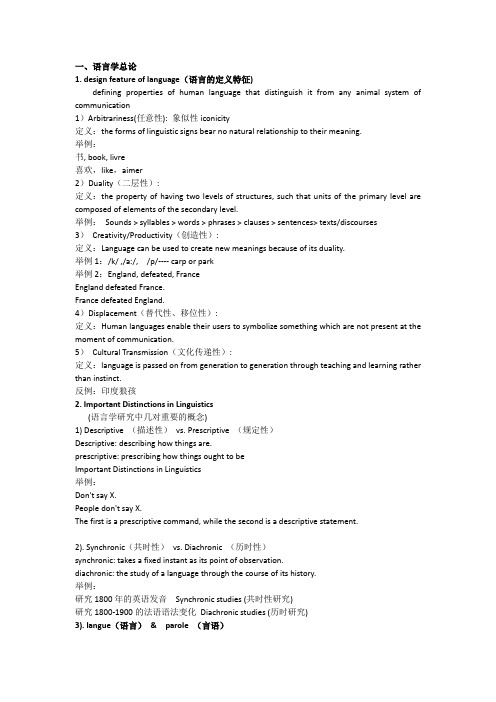
一、语言学总论1. design feature of language(语言的定义特征)defining properties of human language that distinguish it from any animal system of communication1)Arbitrariness(任意性): 象似性iconicity定义:the forms of linguistic signs bear no natural relationship to their meaning.举例:书, book, livre喜欢,like,aimer2)Duality(二层性):定义:the property of having two levels of structures, such that units of the primary level are composed of elements of the secondary level.举例:Sounds > syllables > words > phrases > clauses > sentences> texts/discourses3)Creativity/Productivity(创造性):定义:Language can be used to create new meanings because of its duality.举例1:/k/ ,/a:/, /p/---- carp or park举例2:England, defeated, FranceEngland defeated France.France defeated England.4)Displacement(替代性、移位性):定义:Human languages enable their users to symbolize something which are not present at the moment of communication.5)Cultural Transmission(文化传递性):定义:language is passed on from generation to generation through teaching and learning rather than instinct.反例:印度狼孩2. Important Distinctions in Linguistics(语言学研究中几对重要的概念)1) Descriptive (描述性)vs. Prescriptive (规定性)Descriptive: describing how things are.prescriptive: prescribing how things ought to beImportant Distinctions in Linguistics举例:Don't say X.People don't say X.The first is a prescriptive command, while the second is a descriptive statement.2). Synchronic(共时性)vs. Diachronic (历时性)synchronic: takes a fixed instant as its point of observation.diachronic: the study of a language through the course of its history.举例:研究1800年的英语发音Synchronic studies (共时性研究)研究1800-1900的法语语法变化Diachronic studies (历时研究)3). langue(语言)& parole (言语)Theorist:Saussure(索绪尔), father of modern linguisticslangue: abstract linguistic systemparole: actual realization of langueImportant Distinctions in Linguistics4) Competence(语言能力)and performance (语言运用)theorist: Chomsky(乔姆斯基)competence: user's knowledge of rules about the linguistic system.performance: the actual realization of this knowledge in concrete situations.二、语音学和音系学1.语音学(phonetics)和音系学(phonology)的定义和区别2.语音学重要概念: 清音和浊音3.音系学重要概念: 音子,音位, 超音段特征Phonetics studies all speech sounds in human languages: how they are produced, transmitted and how they are received.Phonology: aims to discover how speech sounds in a language form patternsand how these sounds are used to convey meaning in linguistic communication.区别: meaning(是否研究和表达意义有关的语音)举例:too 和tea 中的/t/发too中的/t/时, 舌位更靠近口腔前部发tea中的/t/时,舌位更靠近口腔后部语音学要研究这种/t/发音的不同之处, 音系学不研究语音学分类articulatory phonetics(发音语音学): speakers productionacoustic phonetics(声学语音学): transmission’s mediumauditory phonetics(听觉语音学): receiver’s receptionHow speech sounds are madeSpeech organsPosition of the vocal folds(声带): voicing(浊音) and voiceless (清音)Voiceless(清音):vocal cords are drawn wide apart, letting the air stream go through without causing obstruction清音举例:[p,s,t]Voicing/Voiced(浊音):vocal cords held together, letting the air stream vibrates浊音: [b,z,d]The distinction between vowels and consonants lies in the obstruction of air stream.As there is no obstruction of air in the production of vowels, the description of the consonants and vowels cannot be done along the same lines.音系学重要概念:Phone(音子):a phonetic unit; the speech sounds we hear and produce during communication are all phones举例:too 和tea 中的/t/发too中的/t/时, 舌位更靠近口腔前部发tea中的/t/时,舌位更靠近口腔后部所以too 和tea 中的/t/两个不同的音子Phoneme(音位): phonological and abstract unit, a unit of distinctive value;the smallest unit of sound in a language which can distinguish two words.举例:tea 和sea, /t/和/s/是两个不同的音位morphemeSuprasegmental features (超音段特征)Suprasegmental features: phonemic features that occur above the level of the segments .The principal suprasegmentals are:stress (重音)举例: perfect (adj) 和perfect (v)tone (声调)/pitch (音高):定义: sound feature which are caused by the differing rate of vibration of the vocal folds.举例: mā妈, má麻, mă马,mà骂比较:英语单词,如meintonation (语调):pitch, stress, and sound length are tied to the sentence rather than the word in isolation.三、Morphology 形态学1. 学科定义2. 语素的定义和分类3. 词的分类(classification of words)形态学研究的基本单位1. morpheme(语素). The most basic element of meaning in language,an element that cannot be further divided into smaller units without altering its meaning.举例:ballfootballballsTypes of MorphemesFree morphemes vs. Bound morphemes(自由语素和黏着语素):Free morphemes: those that may constitute words by themselves, eg boy, girl, table, nation. Bound morphemes: those that cannot occur alone, eg -s, -ed, dis-, un-.Types of Bound MorphemeInflectional morpheme (屈折语素)=inflectional affix(屈折词缀):change the grammatical meaning (number, aspect, case, tense)Derivational morpheme(派生语素)=derivational affix (派生词缀): change the lexical meaningDerivational morpheme(改变词义):改变词义:dis-, un-, multi-, micro-改变词性:en-, -full, -mentInflectional morpheme(改变语法含义):改变名称的性,数,格:-ess, -s,改变动词的时, 态,体: -ing, -ed,改变形容词的级:-er, -est如何区分派生词(derivational word)和合成词(compound word) : 拆开后看各个组成的语素能否都单独成词,如果可以,就是合成词,如果不能就是派生词。
英语语言学概论笔记
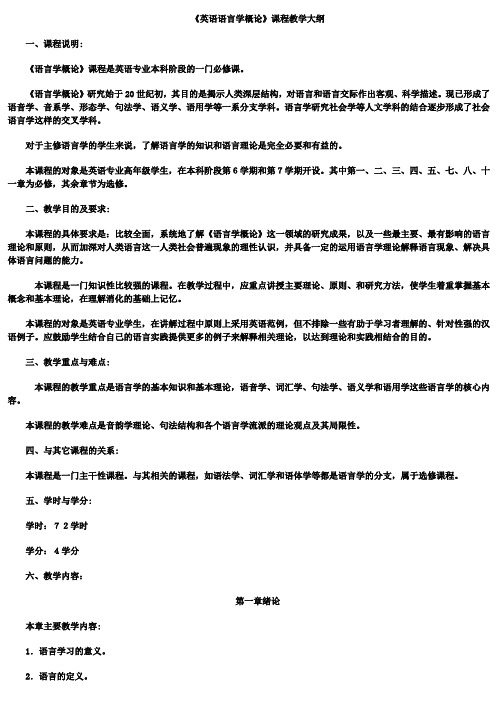
《英语语言学概论》课程教学大纲一、课程说明:《语言学概论》课程是英语专业本科阶段的一门必修课。
《语言学概论》研究始于20世纪初,其目的是揭示人类深层结构,对语言和语言交际作出客观、科学描述。
现已形成了语音学、音系学、形态学、句法学、语义学、语用学等一系分支学科。
语言学研究社会学等人文学科的结合逐步形成了社会语言学这样的交叉学科。
对于主修语言学的学生来说,了解语言学的知识和语言理论是完全必要和有益的。
本课程的对象是英语专业高年级学生,在本科阶段第6学期和第7学期开设。
其中第一、二、三、四、五、七、八、十一章为必修,其余章节为选修。
二、教学目的及要求:本课程的具体要求是:比较全面,系统地了解《语言学概论》这一领域的研究成果,以及一些最主要、最有影响的语言理论和原则,从而加深对人类语言这一人类社会普遍现象的理性认识,并具备一定的运用语言学理论解释语言现象、解决具体语言问题的能力。
本课程是一门知识性比较强的课程。
在教学过程中,应重点讲授主要理论、原则、和研究方法,使学生着重掌握基本概念和基本理论,在理解消化的基础上记忆。
本课程的对象是英语专业学生,在讲解过程中原则上采用英语范例,但不排除一些有助于学习者理解的、针对性强的汉语例子。
应鼓励学生结合自己的语言实践提供更多的例子来解释相关理论,以达到理论和实践相结合的目的。
三、教学重点与难点:本课程的教学重点是语言学的基本知识和基本理论,语音学、词汇学、句法学、语义学和语用学这些语言学的核心内容。
本课程的教学难点是音韵学理论、句法结构和各个语言学流派的理论观点及其局限性。
四、与其它课程的关系:本课程是一门主干性课程。
与其相关的课程,如语法学、词汇学和语体学等都是语言学的分支,属于选修课程。
五、学时与学分:学时:72学时学分:4学分六、教学内容:第一章绪论本章主要教学内容:1.语言学习的意义。
2.语言的定义。
3.语言的定义特征。
4.语言的起源。
5.语言的功能。
6.语言学的定义。
英语语言学笔记(2)
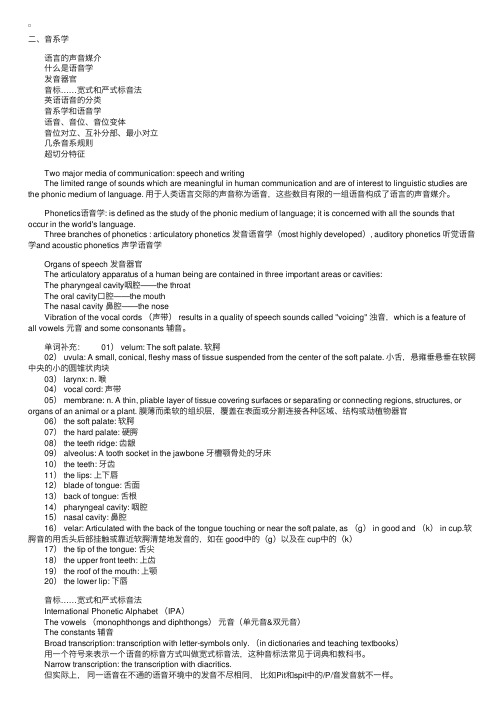
⼆、⾳系学 语⾔的声⾳媒介 什么是语⾳学 发⾳器官 ⾳标……宽式和严式标⾳法 英语语⾳的分类 ⾳系学和语⾳学 语⾳、⾳位、⾳位变体 ⾳位对⽴、互补分部、最⼩对⽴ ⼏条⾳系规则 超切分特征 Two major media of communication: speech and writing The limited range of sounds which are meaningful in human communication and are of interest to linguistic studies are the phonic medium of language. ⽤于⼈类语⾔交际的声⾳称为语⾳,这些数⽬有限的⼀组语⾳构成了语⾔的声⾳媒介。
Phonetics语⾳学: is defined as the study of the phonic medium of language; it is concerned with all the sounds that occur in the world's language. Three branches of phonetics : articulatory phonetics 发⾳语⾳学(most highly developed), auditory phonetics 听觉语⾳学and acoustic phonetics 声学语⾳学 Organs of speech 发⾳器官 The articulatory apparatus of a human being are contained in three important areas or cavities: The pharyngeal cavity咽腔——the throat The oral cavity⼝腔——the mouth The nasal cavity ⿐腔——the nose Vibration of the vocal cords (声带) results in a quality of speech sounds called "voicing" 浊⾳,which is a feature of all vowels 元⾳ and some consonants 辅⾳。
英语语言学概论第十章笔记
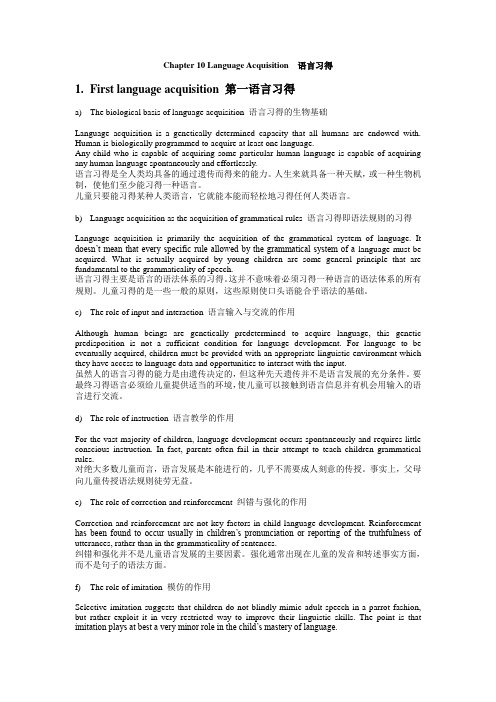
Chapter 10 Language Acquisition 语言习得1.First language acquisition 第一语言习得a)The biological basis of language acquisition 语言习得的生物基础Language acquisition is a genetically determined capacity that all humans are endowed with. Human is biologically programmed to acquire at least one language.Any child who is capable of acquiring some particular human language is capable of acquiring any human language spontaneously and effortlessly.语言习得是全人类均具备的通过遗传而得来的能力。
人生来就具备一种天赋,或一种生物机制,使他们至少能习得一种语言。
儿童只要能习得某种人类语言,它就能本能而轻松地习得任何人类语言。
b)Language acquisition as the acquisition of grammatical rules 语言习得即语法规则的习得Language acquisition is primarily the acquisition of the grammatical system of language. It doesn’t mean that every specific rule allowed by the grammatical system of a language must be acquired. What is actually acquired by young children are some general principle that are fundamental to the grammaticality of speech.语言习得主要是语言的语法体系的习得。
英语语言学概论第七章笔记.
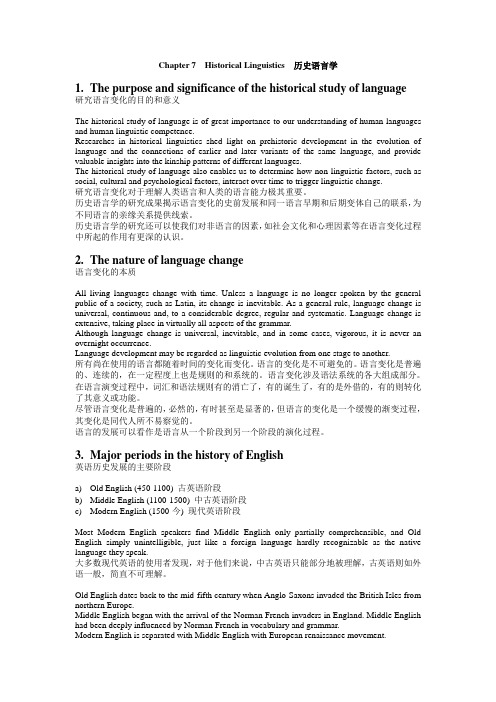
Chapter 7 Historical Linguistics 历史语言学1.The purpose and significance of the historical study of language研究语言变化的目的和意义The historical study of language is of great importance to our understanding of human languages and human linguistic competence.Researches in historical linguistics shed light on prehistoric development in the evolution of language and the connections of earlier and later variants of the same language, and provide valuable insights into the kinship patterns of different languages.The historical study of language also enables us to determine how non-linguistic factors, such as social, cultural and psychological factors, interact over time to trigger linguistic change.研究语言变化对于理解人类语言和人类的语言能力极其重要。
历史语言学的研究成果揭示语言变化的史前发展和同一语言早期和后期变体自己的联系,为不同语言的亲缘关系提供线索。
历史语言学的研究还可以使我们对非语言的因素,如社会文化和心理因素等在语言变化过程中所起的作用有更深的认识。
英语语言学概论笔记(期末复习资料)

英语语言学概论笔记(期末复习资料)【考研1号】专为英语基础一般及薄弱者打造《英语语言学概论》重、难点提示Questions & Answers on Key Points of Linguistics《英语语言学概论》重、难点问与答1.1. What is language?―Language is system of arbitrary vocal symbols used for human communication. It is a system, since linguistic elements are arranged systematically, rather than randomly. Arbitrary, in the sense that there is usually no intrinsic connection between a work (like ―book‖) and the object it refers to. This explains and is explained by the fact that different languag es have different ―books‖: ―book‖ in English,―livre‖ in French, in Japanese, in Chinese, ―check‖ in Korean. It is symbolic, because words are associated with objects, actions, ideas etc. by nothing but convention. Namely, people use the sounds or vocal forms to symbolize what they wish to refer to. It is vocal, because sound or speech is the primary medium for all human languages, developed or―new‖. Writing systems came much later than the spoken forms. The fact that small children learn and can only learn to speak (and listen) before they write (and read) also indicates that language is primarily vocal, rather than written. The term ―human‖ in the definition is meant to specify that language is human specific.1.2. What are design features of language?―Design features‖ here refer to the defining properties of human language that tell thedifference between human language and any system of animal communication. They are arbitrariness, duality, productivity, displacement, cultural transmission and interchangeability1.3. What is arbitrariness?By ―arbitrariness‖, we mean there is no logical connection between meanings and sounds (see I .1). A dog might be a pig if only the first person or group of persons had used it for a pig. Language is therefore largely arbitrary. But language is not absolutely seem to be some sound-meaning association, if we think of echo words, like ―bang‖, ―crash‖, ―roar‖, which are motivated in a certain sense. Secondly, some compounds (words compounded to be one word) are not entirely arbitrary either. ―Type‖ and ―write‖ are opaque orunmotivated words, while ―type-writer‖ is less so, or more transparent or motivated than the words that make it. So we can say―arbitrariness‖ is a matter of degree.1.4.What is duality?Linguist s refer ―duality‖ (of structure) to the fact that in all languages so far investigated, one finds two levels of structure or patterning. At the first, higher level, language is analyzed in terms of combinations of meaningful units (such as morphemes, words etc.); at the second, lower level, it is seen as a sequence of segments which lack any meaning in themselves, but which combine to form units of meaning.According to Hu Zhanglin et al. (p.6), language is a system of two sets of structures, one of sounds and the other of meaning. This is important for the workings of language. A small number of semantic units (words), and these units of meaning can be arranged and rearranged into aninfinite更多精华请登陆考研1号网 【考研1号】专为英语基础一般及薄弱者打造number of sentences (note that we have dictionaries of words, but no dictionary of sentences!). Duality makes it possible for a person totalk about anything within his knowledge. No animal communication system enjoys this duality, or even approaches this honor.1.5.What is productivity?Productivity refers to the ability to the ability to construct and understand an indefinitely large number of sentences in one’s native language, including those that has never heard before, but that are appropriate to the speaking si tuation. No one has ever said or heard ―A red-eyed elephant is dancing on the small hotel bed with an African gibbon‖, but he cansay it when necessary, and he can understand it in right register. Different from artistic creativity, though, productivity never goes outside the language, thus also called ―rule-bound creativity‖ (byN.Chomsky).1.6.What is displacement?―Displacement‖, as one of the design features of the human language, refers to the fact that one can talk about things that are not present, as easily as he does things present. In other words, one can refer to real and unreal things, things of the past, of the present, of the future. Language itself can be talked about too. When a man, for example, is crying to a woman, about something, it might be something that had occurred, or something that is occurring, or something that is to occur. When a dog is barking, however, you can decide it is barking for something or at someone that exists now and there. It couldn’t be bow wowing sorrowfully for dome lost love or a bone to be lost. The bee’s system, nonetheless,has a small share of ―displacement‖, but it is an unspeakable tiny share.1.7.What is cultural transmission?This means that language is not biologically transmitted from generation to generation, but that the details of the linguistic system must be learned anew by each speaker. It is true that the capacity for language in human beings (N. Chomsky called it ―language acquisition device‖, or LAD) has a genetic basis, but the particular language a person learns to speak is a cultural one other than a genetic one like the dog’s barking system. Ifa human being is brought up in isolation he cannot acquire language. The Wolf Child reared by the pack of wolves turned out to speak thewolf’s roaring ―tongue‖ when he was saved. He learned thereafter, with no small difficulty, the ABC of a certain human language.1.8.What is interchangeability?(1) Interchangeability means that any human being can be both a producer and a receiver of messages. We can say, and on other occasions can receive and understand, for example, ―Please do something to make me happy.‖ Though some people (including me) suggest that there is sex differentiation in the actual language use, in other words, men and women may say different things, yet in principle there is no sound, or word or sentence that a man can utter and a woman cannot, or vice versa. On the other hand, a person can be the speaker while the other person is the listener and as the turn moves on to the listener, he can be the speaker and the first speaker is to listen. It is turn-taking that 更多精华请登陆考研1号网 【考研1号】专为英语基础一般及薄弱者打造makes social communication possible and acceptable.(2) Some male birds, however, utter some calls, which females do not (or cannot?), and certain kinds of fish have similar haps mentionable. When a dog barks, all the neighboring dogs bark. Then people around can hardly tell which dog (dogs) is (are0 ―speaking‖ and which listening.1.9.Why do linguists say language is human specific?First of all, human language has six ―design features‖ whichanimal communication systems do not have, at least not in the true sense of them (see I .2-8). Let’s borrow C. F.Hocket’s Chart that compares human language with some animals’ systems, from Wang Gang (1998,p.8).Secondly, linguists have done a lot trying to teach animals such as chimpanzees to speak a human language but have achieved nothing inspiring. Beatnice and Alan Gardner brought up Washoe, a female chimpanzee, like a hum an child. She was taught ―American sign Language‖, and learned a little that made the teachers happy but did mot make the linguistics circle happy, for few believed in teaching chimpanzees.Thirdly, a human child reared among animals cannot speak a human language, not even when he is taken back and taught to lo to so (see the ―Wolf Child‖in I.7)1.10.What functions does language have?Language has at least seven functions: phatic, directive, Informative, interrogative, expressive, evocative and per formative. According to Wang Gang (1988,p.11), language has three main functions: a tool of communication, a tool whereby people learn about the world, and a tool by which people learn about the world, and a tool by which people create art. M .A. K.Halliday, representative of the London school, recognizes three ―Macro-Functions‖: ideational, interpersonal and textual (see! 11-17;see HU Zhuanglin etal., pp10-13, pp394-396).1. 11What is the phatic function?The ―phatic function‖ refers to language being used for setting up a certain atmosphere or maintaining social contacts (rather than for exchanging information or ideas). Greetings, farewells, and comments on the weather in English and on clothing in Chinese all serve this function. Much of the phatic langua ge (e.g. ―How are you?‖ ―Fine, thanks.‖) Is insincere if taken literally, but it is important. If you don't say ―Hello‖ to a friend you meet, orif you don’t answer his ―Hi‖, you ruin your friendship.1.12. What is the directive function?The ―directive function‖ means that language may be used to get the hearer to do something. Most imperative sentences perform this function, e.g., ―Tell me the result whenyou finish.‖ Other syntactic structures or sentences of other sorts can, according to J.Austin an d J.Searle’s ―indirect speech act theory‖(see Hu Zhuanglin et al., pp271-278)at least, serve the purpose of direction too, e.g., ―If I were you, I would have blushed to the bottom of my ears!‖更多精华请登陆考研1号网 【考研1号】专为英语基础一般及薄弱者打造1.13.What is the informative function?Language serves an ―informational function‖ when used to tell something, characterized by the use of declarative sentences. Informative statements are often labeled as true (truth) or false (falsehood). According to P.Grice’s―Cooperative Principle‖(see HuZhuanglin et al., pp282-283), one ought not to violate the ―Maxim of Quality‖, when he is informing at all.1.14.What is the interrogative function?When language is used to obtain information, it serves an―interrogative function‖. This includes all questions that expect replies, statements, imperatives etc., according to the ―indirect speech act theory‖, may have this function as well, e.g., ―I’d liketo know you better.‖ This may bring forth a lot of personal information. Note that rhetorical questions make an exception, since they demand no answer, at least not the reader’s/listener’s answer.1.15.What is the expressive function?The ―expressive function‖ is the use of language to reveal something about the feelings or attitudes of the speaker. Subconscious emotional ejaculations are good examples, like ―Good heavens!‖ ―My God!‖ Sentences like ―I’m sorry about the delay‖ can serve as good examples too, though in a subtle way. While language is used for the informative function to pass judgment on the truth or falsehood of statements, language used for the expressive function evaluates, appraises or asserts the speaker’s own attitudes.1.16.What is the evocative function?The ―evocative function‖ is the use of language to create certain feelings in the hearer. Its aim is, for example, to amuse, startle, antagonize, soothe, worry or please. Jokes (not practical jokes, though) are supposed to amuse or entertain the listener; advertising to urgecustomers to purchase certain commodities; propaganda to influence public opinion. Obviously, the expressive and the evocative functions often go together, i.e., you may express, for example, your personal feelings about a political issue but end up by evoking the same feeling in, or imposing it on, your listener. That’s also the case with the other way round.1.17.What is the per formative function?This means people speak to ―do things‖ or perform actions. On certain occasions theutterance itself as an action is more important than what words or sounds constitute the uttered sentence. When asked if a third Yangtze Bridge ought to be built in Wuhan, the mayor may say, ―OK‖, which means more than speech, and more than an average socialindividual may do for the construction. The j udge’s imprisonment sentence, the president’s war or independence declaration, etc., are per formatives as well (see J.Austin’s speech Act Theory, Hu Zhuanglin, ecal.pp271-278).1.18.What is linguistics?―Linguistics‖ is the scientific study of language. It studies not just one language of any one更多精华请登陆考研1号网 【考研1号】专为英语基础一般及薄弱者打造society, but also the language of all human beings. A linguist, though, does not have to know and use a large number of languages, butto investigate how each language is constructed. He is also concerned with how a language varies from dialect to dialect, from class to class, how it changes from century to century, how children acquire their mother tongue, and perhaps how a person learns or should learn a foreign language. In short, linguistics studies the general principles whereupon all human languages are constructed and operate as systems of communication in their societies or communities (see Hu Zhuanglin et al., pp20-22)1.19.What makes linguistics a science?Since linguistics is the scientific study of language, it ought to base itself upon the systematic, investigation of language data, which aims at discovering the true nature of language and its underlying system. To make sense of the data, a linguist usually has conceived some hypotheses about the language structure, to be checked against the observed or observable facts. In order to make his analysis scientific, a linguist is usually guided by four principles: exhaustiveness, consistency, and objectivity. Exhaustiveness means he should gather all the materials relevant to the study and give them an adequate explanation, in spite of the complicatedness. He is to leave nolinguistic ―stone‖ unturned. Consistency means there should be no contradiction between different parts of the total statement. Economy means a linguist should pursue brevity in the analysis when it is possible. Objectivity implies that since some people may be subjectivein the study, a linguist should be (or sound at least) objective,matter-of-face, faithful to reality, so that his work constitutes partof the linguistics research.1.20.What are the major branches of linguistics?The study of language as a whole is often called general linguistics (e.g.Hu Zhuanglin et al., 1988;Wang Gang, 1988). But a linguist sometimes is able to deal with only one aspect of language at a time, thus the arise of various branches: phonetics, phonology, morphology, syntax, semantics, sociolinguistics, applied linguistics, pragmatics, psycholinguistics, lexicology, lexicography, etymology, etc.1.21.What are synchronic and diachronic studies?The description of a language at some point of time (as if itstopped developing) is a synchrony study (synchrony). The description of a language as it changes through time is a diachronic study (diachronic). An essay entitled ―On the Use of THE‖, for example, may be synchronic, if the author does not recall the past of THE, and it may also be diachronic if he claims to cover a large range or period of time wherein THE has undergone tremendous alteration (see Hu Zhuanglin et al., pp25-27).1.22.What is speech and what is writing?(1) No one needs the repetition of the general principle oflinguistic analysis, namely, the primacy of speech over writing. Speechis primary; because it existed long long before writing systems cameinto being. Genetically children learn to speak before learning to write.Secondly, written forms just represent in this way or that the speech sounds:更多精华请登陆考研1号网 【考研1号】专为英语基础一般及薄弱者打造individual sounds, as in English and French as in Japanese.(2) In contrast to speech, spoken form of language, writing aswritten codes, gives language new scope and use that speech does not have. Firstly, messages can be carried through space so that people can write to each other. Secondly, messages can be carried through time thereby, so that people of our time can be carried through time thereby, so that people of our time can read Beowulf, Samuel Johnson, and Edgar A. Poe. Thirdly, oral messages are readily subject to distortion, either intentional or unintentional (causing misunderstanding or malentendu), while written messages allow and encourage repeated unalterable reading.(3) Most modern linguistic analysis is focused on speech, different from grammarians of the last century and theretofore.1.23.What are the differences between the descriptive and the prescriptive approaches? A linguistic study is ―descriptive‖ if itonly describes and analyses the facts of language, and ―prescriptive‖ if it tries to lay down rules for ―correct‖ language behavior. Linguisticstudies before this century were largely prescriptive because many early grammars were largely prescriptive because many early grammars were based on ―high‖ (literary or reli gious) written records. Modernlinguistics is mostly descriptive, however. It (the latter) believesthat whatever occurs in natural speech (hesitation, incomplete utterance, misunderstanding, etc.) should be described in the analysis, and not be marked as incorrect, abnormal, corrupt, or lousy. These, with changes in vocabulary and structures, need to be explained also.1.24.What is the difference between langue and parole?F. De Saussure refers ―langue‖to the abstract linguistic system shared by all the members of a speech community and refers ―parole‖ to the actual or actualized language, or the realization of langue. Langue is abstract, parole specific to the speaking situation; langue not actually spoken by an individual, parole always a naturally occurring event; langue relatively stable and systematic, parole is a mass of confused facts, thus not suitable for systematic investigation. What a linguist ought to do, according to Saussure, is to abstract langue from instances of parole, I. e. to discover the regularities governing all instances of parole and make than the subject of linguistics. Thelangue-parole distinction is of great importance, which casts great influence on later linguists.1.25.What is the difference between competence and performance?(1) According to N. Chomsky, ―competence‖ is the ideal language user’s knowledge of the rules of his language, and ―performance‖ is the actual realization of this knowledge in utterances. The former enables a speaker to produce and understand an indefinite number of sentences and to recognize grammatical mistakes and ambiguities. Aspeaker’s competence is stable while his performance is often influenced by psychological and social factors. So a speaker’s performance does not always match or equal his supposed competence.(2) Chomsky believes that linguists ought to study competence,rather than performance. In other words, they should discover what an ideal speaker knows of his更多精华请登陆考研1号网 【考研1号】专为英语基础一般及薄弱者打造native language.(3) C homsky’s competence-performance distinction is not exactly the same as,though similar to, F. de Saussure’s langue-parole distinction. Langue is a social product,and a set of conventions for a community, while competence is deemed as a property of the mind of each individual. Sussure looks at language more from a sociological or sociolinguistic point of view than N. Chomsky since the latter deals with his issues psychologically or psycholinguistically.1.26.What is linguistic potential? What is actual linguistic behavior?M. A. K. Halliday made these two terms, or the potential-behavior distinction, in the 1960s, from a functional point of view. There is a wide range of things a speaker can do in his culture, and similarly there are many things he can say, for example, to many people, on manytopics. What he actually says (i.e. his ―actual linguistic behavior‖) on a certain occasion to a certain person is what he has chosen from many possible injustice items, each of which he could have said (linguistic potential).1.27.In what way do language, competence and linguistic potential agree? In what way do they differ? And their counterparts?Langue, competence and linguistic potential have some similar features, but they are innately different (see 1.25). Langue is a social product, and a set of speaking conventions; competence is a property or attribute of each ideal speaker’s mind; linguistic potential is all the linguistic corpus or repertoire available from which the speaker chooses items for the actual utterance situation. In other words, langue is invisible but reliable abstract system. Competence means ―knowing‖, and linguistic potential a set of possibilities for ―doing‖ or―performing actions‖. They are similar in that they all refer to the constant underlying the utterances that constitute what Saussure, Chomsky and Halliday respectively called parole, performance and actual linguistic behavior. Paole, performance and actual linguistic behavior enjoy more similarities than differences.1.28.What is phonetics?―Phonetics‖ is the science which studies the characteristics of human sound-making,especially those sounds used in speech, and provides methods fortheir description, classification and transcription (see Hu Zhuanglin etal., pp39-40), speech sounds may be studied in different ways, thus by three different branches of phonetics. (1) Articulatory phonetics; the branch of phonetics that examines the way in which a speech sound is produced to discover which vocal organs are involved and how they coordinate in the process. (2) Auditory phonetics, the branch ofphonetic research from the hearer’s point ofview, looking into the impression which a speech sound makes on the hearer as mediated by the ear, the auditory nerve and the brain. (3) Acoustic phonetics: the study of the physical properties of speech sounds, as transmitted between mouth and ear. Most phoneticians, however, are interested in articulator phonetics.1.29.How are the vocal organs formed?The vocal organs (see Figure1, Hu Zhuanglin et al., p41), or speech organs, are organs of更多精华请登陆考研1号网 【考研1号】专为英语基础一般及薄弱者打造the human body whose secondary use is in the production of speech sounds. The vocal organs can be considered as consisting of three parts; the initiator of the air-stream, the producer of voice and theresonating cavities.1.30.What is place of articulation?It refers to the place in the mouth where, for example, the obstruction occurs, resulting in the utterance of a consonant. Whatever sound is pronounced, at least some vocal organs will get involved. g.Lips, hard palate etc., so a consonant may be one of the following (1) bilabial: [p, b, m]; (2) labiodental: [f, v]; (3) dental: [,]; (4) alveolar: [t, d, l, n.s, z]; (5) retroflex; (6) palato-alveolar: [,]; (7) palatal: [j]; (8) velar [k, g,]; (9) uvular; (10) glottal: [h]. Some sounds involve the simultaneous use of two places of articulation. For example, the English [w] has both an approximation of the two lips and those two lips and that of the tongue and the soft palate, and may be termed ―labial-velar‖.1.31.What is the manner of articulation?The ―manner of articulation‖ literally means the way a sound is articulated. At a given place of articulation, the airstreams may be obstructed in various ways, resulting in various manners of articulation, are the following: (1) plosive: [p, b, t, d, k, g]; (2) nasal: [m, n,]; (3) trill; (4) tap or flap; (5) lateral: [l]; (6) fricative: [f, v, s, z]; (7) approximant: [w, j]; (8) affricate: [].1.32.How do phoneticians classify vowels?Phoneticians, in spite of the difficulty, group vowels in 5 types: (1) long and short vowels, e.g.,[i:,]; (4) rounded and unroundvowels,e.g.[,i]; (5) pure and gliding vowels, e.g.[I,].1.33.What is IPA? When did it come into being ?The IPA, abbreviation of ―International Phonetic Alphabet‖, is a compromise system making use of symbols of all sources, including diacritics indicating length, stress and intonation, indicating phoneticvariation. Ever since it was developed in 1888, IPA has undergone a number of revisions.1.34.What is narrow transcription and what is broad transcription?In handbook of phonetics, Henry Sweet made a distinction between―narrow‖ and ―broad‖ transcriptions, which he called ―Narrow Romic‖. The form er was meant to symbolize all the possible speech sounds, including even the most minute shades of pronunciation while Broad Romic or transcription was intended to indicate only those sounds capable of distinguishing one word from another in a given language.1.35.What is phonology? What is difference between phonetics and phonology? (1) ―Phonology‖ is the study of sound systems- the invention of distinctive speechsounds that occur in a language and the patterns wherein they fall. Minimal pair, phonemes, allophones, free variation, complementary distribution, etc., are all to be investigated by a phonologist.(2) Phonetics, as discussed in I.28, is the branch of linguistics studying the更多精华请登陆考研1号网 【考研1号】专为英语基础一般及薄弱者打造characteristics of speech sounds and provides methods for their description, classification and transcription. A phonetist is mainly interested in the physical properties of the speech sounds, whereas a phonologist studies what he believes are meaningful sounds related with their semantic features, morphological features, and the way they areconceived and printed in the depth of the mind phonological knowledge permits a speaker to produce sounds which from meaningful utterances, to recognize a foreign ―accent‖, to make up new words, to add the appropriate phonetic segments to from plurals and past tenses, to know what is and what is not a sound in one’s language.1.36.What is a phone? What is a phoneme? What is an allophone?(1) A ―phone‖ is a phonetic unit or segment. T he speech sounds we hear and produce during linguistic communication are all phones. When we hear the following words pronounced:[pit], [tip], [spit], etc., the similar phones we have heard are [p] for one thing, and threedifferent[p]’s, readily making possible the ―narrow transcription or diacritics‖. Phones may and may not distinguish meaning. A ―phoneme‖ is a phonological unit; it is a unit that is of distinctive value. As an abstract unit, a phoneme is not any particular sound, but rather it is represented or realized by a certain phone in a certain phonetic context. For example, the phoneme[p] is represented differently in [pit], [tip] and [spit].(2) The phones representing a phoneme are called its ―allophones‖,i. e., the different (i.e., phones) but do not make one word so phonetically different as to create a new word or a new meaning thereof. So the different[p]’s in the above words are theallophones of the same phoneme[p]. How a phoneme is represented by a phone, or which allophone is to be used, is determined by the phonetic context in which it occurs. But the choice of an allophone is not random.In most cases it is rule-governed; these rules are to be found out by a phonologist.1.37.What are minimal pairs?When two different phonetic forms are identical in every way except for one sound segment which occurs in the same place in the string , the two forms(i. e., word) are supposed to form a ―minimal pair‖, e.g.,―pill‖ and ―bill‖, ―pill‖ and ―till‖, ―till‖ and ―dill‖,―till‖ and ―kill‖, etc. All these words together constitute a minimal set. They are identical in form except for the initial consonants. There are many minimal pairs in English, which makes it relatively easy to know what are English phonemes. It is of great importance to find the minimal pairs when a phonologist is dealing with the sound system of an unknown language(see Hu Zhuanglin et al., pp65-66).1.38.What is free variation?If two sounds occurring in the same environment do not contrast; namely, if the substitution of one for the other does not generate a new word form but merely a different pronunciation of the same word, the two sounds then are said to be in ―free variation‖. Theplosives, for example, may not be exploded when they occur before another plosive or a nasal (e. g., act, apt, good morning). The minute distinctions may, if necessary, be transcribed in diacritics. These unexploded and exploded plosives are in free variation.更多精华请登陆考研1号网 。
- 1、下载文档前请自行甄别文档内容的完整性,平台不提供额外的编辑、内容补充、找答案等附加服务。
- 2、"仅部分预览"的文档,不可在线预览部分如存在完整性等问题,可反馈申请退款(可完整预览的文档不适用该条件!)。
- 3、如文档侵犯您的权益,请联系客服反馈,我们会尽快为您处理(人工客服工作时间:9:00-18:30)。
Chapter 7 Historical Linguistics 历史语言学1.The purpose and significance of the historical study of language研究语言变化的目的和意义The historical study of language is of great importance to our understanding of human languages and human linguistic competence.Researches in historical linguistics shed light on prehistoric development in the evolution of language and the connections of earlier and later variants of the same language, and provide valuable insights into the kinship patterns of different languages.The historical study of language also enables us to determine how non-linguistic factors, such as social, cultural and psychological factors, interact over time to trigger linguistic change.研究语言变化对于理解人类语言和人类的语言能力极其重要。
历史语言学的研究成果揭示语言变化的史前发展和同一语言早期和后期变体自己的联系,为不同语言的亲缘关系提供线索。
历史语言学的研究还可以使我们对非语言的因素,如社会文化和心理因素等在语言变化过程中所起的作用有更深的认识。
2.The nature of language change语言变化的本质All living languages change with time. Unless a language is no longer spoken by the general public of a society, such as Latin, its change is inevitable. As a general rule, language change is universal, continuous and, to a considerable degree, regular and systematic. Language change is extensive, taking place in virtually all aspects of the grammar.Although language change is universal, inevitable, and in some cases, vigorous, it is never an overnight occurrence.Language development may be regarded as linguistic evolution from one stage to another.所有尚在使用的语言都随着时间的变化而变化。
语言的变化是不可避免的。
语言变化是普遍的、连续的,在一定程度上也是规则的和系统的。
语言变化涉及语法系统的各大组成部分。
在语言演变过程中,词汇和语法规则有的消亡了,有的诞生了,有的是外借的,有的则转化了其意义或功能。
尽管语言变化是普遍的,必然的,有时甚至是显著的,但语言的变化是一个缓慢的渐变过程,其变化是同代人所不易察觉的。
语言的发展可以看作是语言从一个阶段到另一个阶段的演化过程。
3.Major periods in the history of English英语历史发展的主要阶段a)Old English (450-1100) 古英语阶段b)Middle English (1100-1500) 中古英语阶段c)Modern English (1500-今) 现代英语阶段Most Modern English speakers find Middle English only partially comprehensible, and Old English simply unintelligible, just like a foreign language hardly recognizable as the native language they speak.大多数现代英语的使用者发现,对于他们来说,中古英语只能部分地被理解,古英语则如外语一般,简直不可理解。
Old English dates back to the mid-fifth century when Anglo-Saxons invaded the British Isles from northern Europe.Middle English began with the arrival of the Norman French invaders in England. Middle English had been deeply influenced by Norman French in vocabulary and grammar.Modern English is separated with Middle English with European renaissance movement.古英语源自欧洲大陆的盎格鲁撒克逊民族所操的语言。
中古英语深受诺曼底占领者所操的法语的影响。
词汇和语法等均受其影响。
现代英语是英语自身发展和欧洲文艺复兴运动渗透结合的产物,很多词汇是外来语。
As British influence reached other continen ts, the “British Empire” established English-speaking colonies in many parts of the world. English is now the native language in the United States, Canada, Australia and New Zealand.英帝国的兴起及其移民化过程的成功使现代英语的使用遍布全球。
以现代英语为母语的国家包括英国、美国、加拿大、澳大利亚和新西兰等。
4.Linguistic change in English英语语言系统的变化Language change is essentially a matter of change in the grammar. We refer to the change in the grammar of a language as linguistic change. Linguistic change occurs in all components of the grammar, including changes in the sound, morphological, syntactic, lexical and semantic systems. 语言变化实质上是语法变化。
我们把一种语言的语法变化称为语言变化。
语言变化包括语音系统、形态系统、句法系统、词汇系统和语义系统等部分的变化。
a)sound change 语音变化●V owel sound change 元音变化The change occurred at the end of the Middle English period, approximately 1400-1600. These changes led to one of the major discrepancies between the phonemic representations of words and morphemes, that is, between the pronunciation and the spelling system of Modern English. Known as the Great Vowel Shift in the history of English, these changes involve seven long, or tense, vowels. Refer to P132 of the test book for examples.元音变化出现在中古英语后期,大约在1400到1600年之间。
这些变化使一些单词的音位表达和词素之间出现了很大的不一致。
这些变化在英语史上被称为元音大变位,涉及七个长元音,或紧元音。
实例见书本132页。
●Sound loss 语音消失Not only did types of vowel sounds change, but some sounds simply disappeared from the general pronunciation of English.不仅数种元音发生了变化,而且一些语音还从英语的整个发音体系中消失了。
实例:1》古英语中/x/ 在现代英语中已不存在。
如:古英语nicht (night) 读做/nixt/,而现代英语读做/nait/2》古英语和中古英语中有/kn/,都发音,在现代英语中/k/不发音了。
如:knight/knee 在古英语中字母k是发音的,而在现代英语中不发音3》古英语中有一类名词的复数形式不是在词尾加/s/音,而是加/i/这个音,现在没有了。
如:goose的复数形式在古英语中的发音是/go:si/4》现代英语中出现了位于词尾的元音音段的省略现象,称为词尾音脱落。
如:name/love在古英语中发音为/na:ma:/和/lufu/,在中古英语中发音为/na:mə/和/luvə/,而在现代英语中的发音为/neim/和/lΛv/5》词尾音脱落还影响了某些词的拼写。
如:古英语单词helpe随着词尾音的消失,在中古英语和现代英语中拼写成了help●Sound addition 语音增加While some sounds were lost in the course of the historical development of English, other sounds were added. Sound addition includes the gain or insertion of a sound. A change that involves the insertion of a consonant or vowel sound to the middle of a word is known as epenthesis. Refer to P134 of the text book for examples.英语在发展过程中消失了一些语音,但也增加了一些语音。
